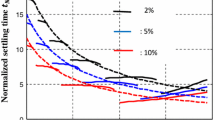Abstract
This paper clearly defines the second order settling time as a special and most important case of the generalized settling time. A new calculation procedure for second order settling time determination is developed, based on a decomposition of deterministic, random or mixed non-stationary signals in steady-state and transient components. A worked out example illustrates the computation procedure. The derived relations can be implemented in the form of computer programs. Although restricted to SISO linear systems, the procedure developed in this paper covers a lot of practical situations like those encountered in sensors and transducers modeling.

Similar content being viewed by others
References
H. Aminzadeh, K. Mafinezhad, R. Lotfi, Design of three-stage nested-miller compensated operational amplifiers based on settling time. Circuits Syst. Signal Process. 3, 164–172 (2009)
L. Arnold, Stochastic Differential Equations: Theory and Applications (Wiley, New York, 1974)
K. Dutton, S. Thompson, B. Barraclough, The Art of Control Engineering (Addison Wesley Longman, Harlow, 1997)
W.M. Haddad, S.G. Nersesov, D. Liang, Finite-time stability for time-varying nonlinear dynamical systems, in American Control Conference (2008), pp. 4135–4139
A.R. Hambley, Electrical Engineering. Principles and Applications (Pearson Education, Upper Saddle River, 2005)
R. Ionel, V. Tiponuţ, S. Ionel, I. Lie, On settling time in electrical circuits with deterministic and random inputs, in Proceedings of the 12th WSEAS International Conference on Circuits. New Aspects of Circuits, vol. 1 (2008), pp. 206–209
S. Ionel, V. Tiponuţ, C. Căleanu, I. Lie, A unified treatment of deterministic and random transients in electrical circuits. WSEAS Trans. Circuits Syst. 7, 87–95 (2008)
S. Ionel, Über die Berechnung Statistischer Mittelwerte für Ausgleichvorgänge. Rev. Roum. Sci. Tech., Sér. Électrotech. Énerg. 36, 215–223 (1991)
D. Joseph, S. Collins, Transient response and fixed pattern noise in logarithmic CMOS image sensors. IEEE Sens. J. 7, 1191–1199 (2007)
B.Y. Kamath, R.G. Meyer, P.R. Gray, Relationship between frequency response and settling time of operational amplifiers. IEEE J. Solid-State Circuits 9, 347–352 (1974)
A. Lecchini, M. Gevers, Explicit expression of the parameter bias in identification of Laguerre models from step responses. Syst. Control Lett. 52, 149–165 (2004)
B.K. Mishra, S. Save, S. Patil, Design and analysis of second and third order PLL at 450 MHz. Int. J. VLSI Des. Commun. Syst. 2, 97–114 (2011)
N.E. Nwaiwu, B. Lingmu, Studies on the effect of settling time on coliform reduction using Moringa Oleifera seed powder. J. Appl. Sci. Environ. Sanit. 6, 279–286 (2011)
A. Papoulis, Probability, Random Variables and Stochastic Processes (McGraw-Hill, New York, 1991)
A. Pugliese, F. Amoroso, G. Cappuccino, G. Cocorullo, Settling-time-oriented design procedure for two-stage amplifiers with current-buffer miller compensation. Rev. Roum. Sci. Tech., Sér. Électrotech. Énerg. 54, 375–384 (2009)
G. Rizzoni, Principles and Applications of Electrical Engineering (McGraw-Hill, Boston, 2004)
H. Schreiber, Zur Berechnung von Schaltvorgängen zufälliger Prozesse bei linearen Systemen. Nachrichtentechnik 17, 361–363 (1967)
P. Schwarz, Die Berechnung von Schaltvorgängen zufälliger Prozesse mit Hilfe der zweiseitigen Laplace-Transformation. Nachrichtentechnik 17, 363–366 (1967)
M.B.B. Sharifian, R. Rahnavard, H. Delavari, Velocity control of DC motor based intelligent methods and optimal integral state feedback controller. Int. J. Comput. Theory Eng. 1, 81–84 (2009)
R.D. Strum, D.E. Kirk, Contemporary Linear Systems Using MATLAB ® 4.0 (PWS, Boston, 1996)
K. Talukdar, A.K. Mitra, A simulation study on the performance of various label-free electronic biosensors. Int. J. Nano Dim. 2(1), 49–54 (2011)
Acknowledgements
This work was partially supported by the strategic Grant POSDRU/89/1.5/S/57649, Project ID 57649 (PERFORM-ERA), co-financed by the European Social Fund – Investing in People, within the Sectoral Operational Programme Human Resources Development 2007–2013.
Author information
Authors and Affiliations
Corresponding author
Rights and permissions
About this article
Cite this article
Ionel, R.C., Ionel, S. & Ignea, A. Calculation of the Second Order Settling Time in SISO Linear Systems. Circuits Syst Signal Process 32, 375–385 (2013). https://doi.org/10.1007/s00034-012-9456-4
Received:
Revised:
Published:
Issue Date:
DOI: https://doi.org/10.1007/s00034-012-9456-4



